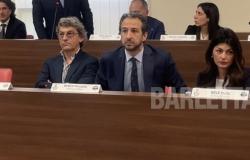PORDENONE – Two hot spots: Mogliano Veneto and Sacile, in the province of Pordenone. Control units that fail at the first rain, dated switches that cause problems with a…
Already a subscriber? Log in here!
SPECIAL OFFER
SPECIAL OFFER
MONTHLY
€4.99
€1 PER MONTH
For 3 months
ACTIVATE NOW
– or –
Subscribe to the subscription by paying with Google
Subscribe
SPECIAL OFFER
Read the article and the entire website ilgazzettino.it
1 year for €9.99 €69.99
Subscribe with Google
or
€1 per month for 3 months
Automatic Renewal. Deactivate whenever you want.
- Unlimited access to articles on the site and app
- The 7.30 am Good Morning newsletter
- All thematic newsletters
- Insights and live updates
- Exclusive live broadcasts
PORDENONE – Two hot spots: Mogliano Veneto and Sacile, in the province of Pordenone. Control units that fail at the first rain, dated switches that cause problems with worrying frequency. Trains forced to stop due to the repercussions of malfunctions that surface one hundred kilometers away from the point reached at that moment by the individual convoy. And delays which, as happened between Tuesday evening and early yesterday morning, often reach two hours. As long as the train is there, because usually cancellations also flock once a month. All garnished by one fact: the line will remain the same at least until the end of the decade. This is the sad fate of the Venice-Udine railway line: it crosses one of the most productive areas of the country but is technologically stuck in the 1960s.
WHAT HAPPEN
Two “blocking” faults per month. It means that every 15 days a problem with greater dynamics, therefore capable of physically blocking the movement of trains, affects transits on the Venice-Udine line. Passengers from the Marche and Friuli Venezia Giulia know this well. Thousands of people move every day. The main problem is that of the control units, which govern the electricity grid. On March 7, the one at Mogliano Veneto, a crucial junction on the Venice-Udine route, broke down. Between Tuesday evening and yesterday morning it happened again. No power, trains stopped. The same thing happened at the end of March and mid-February in Sacile. The source of the problem? Always a control unit. In the town on the Livenza river, a switch (the mechanism that regulates railway exchanges) blocked in March, generating another traffic block. Yet the wave of bad weather that hit Veneto and Friuli Venezia Giulia on Tuesday was not among the worst. This was enough, however, to send more than 120 kilometers of tracks, trains and passengers into disarray. “The strong gusts of wind and the drop in temperatures were a deadly combination for the railway line”, we read in the official notes regarding yesterday morning’s fault, with delays of up to 70 minutes and trains cancelled. The intervention of the technicians allowed a slow return to normality, even if the delays continued until after midday.
THE PAINTING
Another railway line that connects Friuli Venezia Giulia to Veneto is under construction in recent months. In this case we are talking about the Venice-Trieste route, which passing through Portogruaro reaches the Ronchi dei Legionari (Go) airport and then heads for the capital of Fvg. The project to upgrade the Venice Mestre-Ronchi Sud route involves the elimination of singular points or sections that affect the current speed of the route, to allow trains to travel at a maximum speed of 200 kilometers per hour. A plan that RFI plans to complete by 2027. The Venice-Udine line, however, is effectively forgotten. The maximum travel speed (including Italo and Frecce) is 150 kilometers per hour. It is the same that could be achieved in the sixties. Nothing has changed. And there are no substantial interventions on the horizon, other than those linked to ordinary and extraordinary maintenance. The route that passes through cities such as Treviso and Pordenone to reach Udine will remain the same. That is, an old and fault-prone path. «The Italian railway network – explained the regional councilor for Infrastructure of Friuli Venezia Giulia, Cristina Amirante – will move on to address the Udine-Venice problem only after the completion of the upgrading of the “lower” line”. Therefore after 2030, since the works are not even among those scheduled between 2027 and the end of the decade.
© ALL RIGHTS RESERVED
Read the full article at
The Gazzettino




